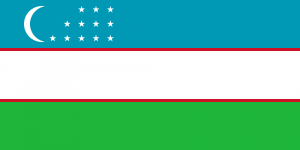Difference between revisions of "Language/Northern-uzbek/Culture/Names-in-Uzbekistan"
m (Quick edit) |
|||
| (One intermediate revision by the same user not shown) | |||
| Line 1: | Line 1: | ||
[[File:Uzbek-Language-PolyglotClub.png|thumb]] | [[File:Uzbek-Language-PolyglotClub.png|thumb]] | ||
'''Uzbek name''' consists of 3, sometimes 4 parts and was adopted from Russian system of last names and patronymics in 20th century with coming of Soviet rule. | '''Uzbek name''' consists of 3, sometimes 4 parts and was adopted from Russian system of last names and patronymics in 20th century with coming of Soviet rule. | ||
First name (ism) for example Amina, is given by parents at birth, second name is patronymic (otasining ismi) for example Anvarovna, which means father’s name plus a suffix –o(ye)vich for males and – o(ye)vna for females and a last name (familiya) for example Oripova, is a family name. | First name (ism) for example Amina, is given by parents at birth, second name is patronymic (otasining ismi) for example Anvarovna, which means father’s name plus a suffix –o(ye)vich for males and – o(ye)vna for females and a last name (familiya) for example Oripova, is a family name. | ||
Since independence of Uzbekistan, some families changed their russified patronymic names to the more traditional “o’g’li” or “qizi” which stands for “son of” or “daughter of”. For example: Amina Anvar qizi Oripova. | Since independence of Uzbekistan, some families changed their russified patronymic names to the more traditional “o’g’li” or “qizi” which stands for “son of” or “daughter of”. For example: Amina Anvar qizi Oripova. | ||
<span link>Take some time to dive into these other pages after completing this lesson:</span> [[Language/Northern-uzbek/Culture/Art-and-Music|Northern Uzbek Culture: Art and Music]], [[Language/Northern-uzbek/Culture/Historical-Sites-and-Landmarks|Historical Sites and Landmarks]], [[Language/Northern-uzbek/Culture/Traditional-Dishes|Traditional Dishes]] & [[Language/Northern-uzbek/Culture/Poetry-and-Prose|Poetry and Prose]]. | |||
== Source == | == Source == | ||
https://slaviccenters.duke.edu/sites/slaviccenters.duke.edu/files/file-attachments/uzbek.original.pdf | https://slaviccenters.duke.edu/sites/slaviccenters.duke.edu/files/file-attachments/uzbek.original.pdf | ||
==Other Lessons== | |||
* [[Language/Northern-uzbek/Culture/Direct-and-Indirect-speech|Direct and Indirect speech]] | |||
<span links></span> | |||
Latest revision as of 13:06, 27 March 2023
Uzbek name consists of 3, sometimes 4 parts and was adopted from Russian system of last names and patronymics in 20th century with coming of Soviet rule.
First name (ism) for example Amina, is given by parents at birth, second name is patronymic (otasining ismi) for example Anvarovna, which means father’s name plus a suffix –o(ye)vich for males and – o(ye)vna for females and a last name (familiya) for example Oripova, is a family name.
Since independence of Uzbekistan, some families changed their russified patronymic names to the more traditional “o’g’li” or “qizi” which stands for “son of” or “daughter of”. For example: Amina Anvar qizi Oripova.
Take some time to dive into these other pages after completing this lesson: Northern Uzbek Culture: Art and Music, Historical Sites and Landmarks, Traditional Dishes & Poetry and Prose.
Source[edit | edit source]
Other Lessons[edit | edit source]
